TUMIPAMPA, PERU — Junior exploration budgets have shrivelled by as much as 39% this year according to a study released in October by SNL Metals Economics Group, but a visit to Dynacor Gold Mines’ (TSX: DNG; US-OTC: DNGDF) operations in Peru proves that there are always exceptions to the rule.
The Montreal-based junior hasn’t had to take an axe to its exploration budget because it earns millions of dollars in profits each year from a wholly owned mill in southern Peru that processes gold from artisanal miners. Last year the mill generated $7.7 million in net profit, and this year the company forecasts net profit will ring in at between $8 million and $9 million.
“In the beginning this mill was seen as a temporary tool to pay for our exploration, but now it’s going to be a permanent division of the company,” Jean Martineau, Dynacor’s president and CEO, explains happily during a five-hour drive to the Huanca mill in Peru’s Acari district, 450 km south of Lima.
“It’s a way to develop the company without dilution,” he continues. “In this difficult market — where most exploration companies don’t have any cash to continue and it’s quite hard for them — we can generate free cash flow and we don’t have to raise money by issuing shares at a low price.”
The strategy was particularly handy after left-leaning former army officer Ollanta Humala became president in June 2011. Humala had campaigned on promises that Peruvians would share the country’s mineral wealth, and his election victory tanked the share prices of many, if not most, companies with mining assets in the country. “It was a huge problem for exploration companies, but for us, our back wasn’t against the wall,” Martineau says. “We didn’t have to finance to pay the bills.”
Next year Dynacor hopes to more than double its 2013 exploration budget of $2 million, and as of Sept. 30 had working capital of $17.3 million, of which $10.3 million was in cash and equivalents. The tightly held company — with just over 36 million shares outstanding — has been debt-free for the last seven months.
The story begins in 1996 when Dynacor management first arrived in Peru and paid $600,000 for a 50% stake in a private company that owned a partly completed, 50-tonne-per-day mill and a small gold-exploration property. The exploration property turned out to be unappealing, but Dynacor spent over $1 million to complete the mill — which it accomplished in 1997 — and poured its first gold in 1998. That year the mill produced just over 3,000 oz. of the yellow metal, and by 2012, annual production had grown to 61,000 oz. gold. Martineau forecasts that figure should climb to 71,000 oz. by year-end.
Recovery rates at the 230-tonne-per-day operation average 94%, and the 300 government-approved artisanal miners who bring their ore to the plant for processing are paid on the basis of the gold content, the milling cost and the recovery rate. Because of the mill’s efficiency, Martineau says, the company can afford to pay a much better price than what the miners can get from other mills in the country, and the profit margin Dynacor receives is about 17%. In the last two years, Dynacor has posted gross margins of US$275 to US$335 per oz. gold.
In the third quarter Dynacor produced 19,741 oz. gold at a gross margin of US$285 per oz., down 13.8% from US$331 per oz. in the year-earlier quarter, due to lower gold prices. The gross operating margin for the quarter was $6 million, up from $5.6 million in the third quarter of 2012.
The milling strategy has been so successful that Dynacor is developing a second gold-processing facility, 150 km south of the Huanca mill in a city called Chala, just off the Pan-American Highway, which runs from north to south in Peru.
The $10-million plant will be built with cash flow from the Huanca mill. Initially it will operate at 300 tonnes per day, but it has been designed so that it can be readily upgraded to 450 tonnes per day and to 600 tonnes per day, as demand requires.
Peru’s government approved the mill’s environmental-impact assessment in December 2012, and Dynacor is waiting for a construction permit. Martineau says it should take six to eight months to build the plant once the company gets the nod from the Ministry of Energy and Mines. He is hopeful that the mill will be up and running in the fourth quarter of 2014.
So far, Dynacor has invested $1.4 million in the Chala plant, and in the third quarter installed an electrical power line that connects the site to the national grid.
Martineau chalks up the construction delay to several factors, including a manpower shortage and mining laws the Peruvian government introduced over the last two years that have enforced environmental laws pertaining to mining and exploration, which have lengthened the time it takes to get approval and permits.
But he says that Peru’s popularity as a mining destination is also to blame for the delays, as mining companies from all over the world, and in particular China, have been inundating the Ministry of Mines with exploration applications in recent months.
Dynacor’s flagship exploration project is a 24-hour journey by road from Chala, or a one-hour helicopter journey from Cuzco. The 48.4 sq. km Tumipampa property, 500 km southeast of Lima, sits at an average altitude of 4,500 metres above sea level in barren plateaus that are characteristic of the Peruvian Andes.
The nearest community in this sparsely populated, windswept mountain range is 28 km north, where mainly cattle breeders and small-scale farmers live. The biggest population centre in the area — Abancay — is 60 km north. The communities in the region typically raise sheep, goat, cattle and chicken in areas close to glacial waters that feed the nearby lakes and rivers.
While the area is quite isolated, a Dynacor map of the region surrounding Tumipampa is dotted with six big mining projects, where mid- and large-tier mining companies are developing skarn porphyry copper-gold mines. Much of this activity, Dynacor claims, began after it took out an option on the property in 2001 and built a road. “The day we built that road other companies started coming in,” Martineau says. “Before that, you had to get there by horseback.”
About 2 km from Tumipampa’s western flank is Southern Copper’s (NYSE: SCCO) Los Chancas project, and to the north and northeast are Xstrata’s (LSE: XTA; US-OTC: XSRAF) Las Bambas, Tintaya and Antapaccay projects, Hudbay Minerals’ (TSX: HBM, NYSE: HBM) Constancia project and First Quantum Minerals’ (TSX: FM; LSE: FQM) Haquira project.
The earliest exploration at Tumipampa dates to colonial times, with signs of adits and in-situ stockpiles of quartz fragments and oxide ore found near the river on the property.
Tumipampa hosts three mineralization types: a copper-gold skarn traced for more than 4 km in length, more than 15 gold-silver veins and disseminated gold mineralization.
The deposit is in a gold-silver vein epithermal corridor that hosts several important hydrothermal deposits, including Minas Buenventura’s (NYSE: BVN) Orcopampa mine (145 km from Tumipampa) and Hochschild Mining’s (LSE: HOC; US-OTC: HCHDF) Ares (186 km from Tumipampa), Arcata (166 km from Tumipampa) and Selene–Pallancata (76 km from Tumipampa).
Tumipampa also strad
dles the Apurimac corridor, which hosts porphyry copper and base-metal, skarn-rich deposits within the Abancay deflection zone.
“We are just at the contact between the Apurimac batholith, a geological structure where you find these big copper porphyry skarns, and a gold-silver belt to the south, another super-giant geological structure, where there are a lot of gold mines,” Martineau says. “We are just on the limit of both and that’s why it is so interesting, and explains why we have found a large copper-gold skarn and gold in veins.”
The rocks are mainly igneous, sedimentary and metamorphic, and chief geologist Alonso Sanchez dates the mineralization back 11 million years. The 30-million-year-old intrusive unit consists of the Apurimac batholith, and the sedimentary rocks, mostly concentrated in the western part of the property, are largely limestones of the Ferrobamba formation of Albian–Cenomanian age from the Middle Cretaceous period. The limestones are concordant and underlie the quartzites (over 80 million years old) of the Soraya formation.
According to Dynacor’s technical report on the property, the Ferrobamba formation is well-known for its metallogenic potential and for polymetallic skarn-type deposits like Xstrata’s Tintaya project. The metamorphic rocks are quartzite units, which are part of the Soraya formation of Lower Cretaceous age.
Dynacor started exploration work in 2001 in an area of the property where Spanish settlers had previously mined five high-grade gold-silver epithermal veins. The company drilled 16 drill holes between 2002 and 2003, with notable intercepts including 1.89 grams gold per tonne over 30 metres, 8.20 grams gold over 3.4 metres and 12.25 grams gold over 1.2 metres.
The exploration crew caught a big break in 2003 when a construction crew using a small D-4 Caterpillar to excavate a road uncovered a horizontal vein Dynacor calls the “Manto Dorado.” Surface sampling of an outcrop of the Manto Dorado returned 6.69 grams gold over 4.9 metres.
But figuring out the lay of the deposit took them a lot longer than it should have, Martineau admits. The main reason was that the company’s geologist apparently overlooked what the drill results were telling him, Martineau and Sanchez say.
“He was so blinded in his hunt for disseminated that he misinterpreted the drill results,” Sanchez says. “He also couldn’t find which direction the Manto Dorado went . . . he thought there must have been a fault. It happens sometimes, when a geologist can’t find the structure, he blames it on a fault.”
“The geologist told us the porphyry was there but it was very, very deep, so it was uneconomic and the veins were small,” Martineau adds.
Because of this, exploration ground to a halt in 2004, and it wasn’t until 2006 that Dynacor took a second look at the property. Management knew they needed another geologist to help them, and so Martineau tracked down Sanchez, a geologist recommended by one of the country’s top university professors, and found that he was working at Buenaventura. Martineau invited Sanchez to the property to see whether he might be able to interpret the geology and the earlier drill results differently.
Sanchez recalls that on his first trip to the project in 2006, his main objective was to check the Manto Dorado and see whether he could figure out its orientation. The first thing that became obvious, he says, was that the previous geologist had been drilling in the wrong direction. “I believed that the dip was down toward the mountain, not away from it, and we proved it with one drill hole,” he says.
“It completely changed the situation here,” Martineau says, picking up the story. “Many mines have been discovered that way — by accident or by looking at the geology in a new way. Look at the Doyon mine, for example. It’s the biggest mine in Quebec. They were finding small gold veins all over the place, but they couldn’t find the pattern. Many geologists passed over it, but it took them decades to figure out where the majority of the gold was.”
Dynacor’s board approved a small exploration budget of $400,000, and Sanchez, who left Buenaventura to join Dynacor in 2006, drilled his first six holes. Three of them struck gold. Hole 3 intersected the Manto Dorado at 50.8 metres, with 12.80 grams gold per tonne over 1.4 metres; and hole 6, which intersected the Manto Dorado at 50.8 metres, returning 23.80 grams gold over 1.2 metres.
Several of the other holes intersected veins, while two drill holes in the northern part of the property, within a skarniferous horizon of the metasomatized limestone of the Ferrobamba formation, returned intercepts of 15.28 grams gold over 4.9 metres in hole 19, and 1.21 grams gold over 1.1 metres in hole 20.
Sanchez followed up the drilling in 2009 with reconnaissance mapping and a sampling program, in which he collected 613 chip and channel samples over a north- to west-striking skarn unit 3 to 4 km long by 0.5 to 1.5 km wide. The exploration work revealed four mineralized zones within the skarn that had significant copper, gold, silver and bismuth. In 2010 Sanchez collected hundreds more surface channel samples from exposed outcropping.
Dynacor completed a geophysical survey and magnetic and induced-polarization surveys over 52 km in 2011, and drilled seven diamond drill holes. The most significant intercept recorded 10.6 metres grading 1.196% copper, 0.634 oz. silver per tonne and 0.17 gram gold per tonne.
Then, in early December 2012, Dynacor started an exploration campaign consisting of diamond drilling in a northern part of the skarn known as Zone 4, and excavated a 300-metre cross-cut into gold-vein structures south of the skarn. All six drilling targets were chosen based on geophysics chargeability anomalies and coincident surface grab-sample anomalies.
“The beauty of the cross-cut is that it gives you access to drill underground, which is much cheaper, and you are much closer to the structures,” Martineau explains as he leads visitors through the adit into the side of the mountain. “The other advantage is that your adits are already done. When you are in production, it gives you access to the ore.”
Results of channel sampling on the north wall, south wall and on the roof of the cross-cut returned impressive intercepts. Roof sampling returned an average grade of 36.48 grams gold over 4.9 metres; sampling of the north wall returned an average grade of 15.58 grams gold; and samples taken from the south wall returned an average grade of 14.35 grams gold.
Underground drilling from within the Manto Dorado got underway in August 2013, and in September Dynacor announced that it had discovered disseminated gold mineralization in brecciated quartzite rock in a new area of the property. The discovery was 2 km southwest of the Manto Dorado structure and 1 km south of Zone 4 on the skarn.
Dynacor has drilled 30 holes on the property for a total of 12,000 metres. “We now know where the manto goes, so instead of continuing to take more soil samples, I prefer to drill,” Sanchez says. “I have the strike of the manto.”
Looking ahead to 2014, Martineau says the company has enough cash in the bank to increase exploration, continue the cross-cut for up to 800 metres, carve other adits into the Manto Dorado and finish more underground drilling.
“We’re still a small company,” Martineau says, “but when you compare us with many other exploration companies, we’re in a great position.”

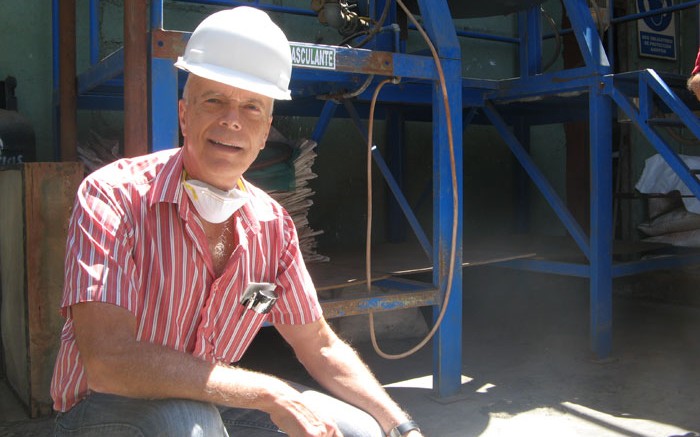
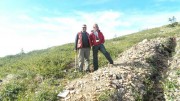
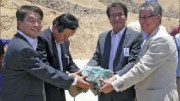
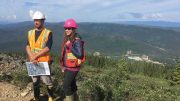
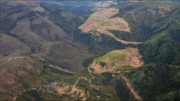
Be the first to comment on "Dynacor’s strategy sets it apart"